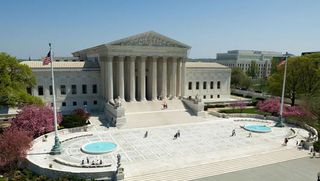Supreme Court to Hold Virtual Oral Argument

The Supreme Court has tacitly conceded that live audio of oral arguments is an important tool to reach the people who can't be in the courtroom, but it is still not making that audio available beyond the journalists who cover the arguments.
So, in essence it will create a virtual press gallery to relay the info to the public, but not let them hear it firsthand.
Related: Open Court Advocates Say Justice Doesn't Have to Be Delayed
The court said Monday (April 13) that after postponing arguments the past two months due to the pandemic, it would hold arguments by teleconference on a select number of those postponed cases next month and "anticipated" that it would provide a live audio feed to news media, though it was not clear how that would be done--a pool feed, perhaps, or call-in number for the conference. The court said more details would be forthcoming, but had not forthcome at press time.
The Supreme Court building remains open, though most staffers are teleworking.
Fix the Court, which was pushing for virtual arguments open to the public, was not pleased that the court did not plan simply to stream the audio so all could hear.
“All across the country, state and federal appeals courts have found a way to allow both the press and public to listen to arguments, but apparently only the press will be invited to access the Supreme Court’s remote arguments next month," said Fix the Court executive director Gabe Roth. "This type of exclusion is patronizing and unjustifiable."
Multichannel Newsletter
The smarter way to stay on top of the multichannel video marketplace. Sign up below.
He said that if the court gives journalists the call-in number for the teleconference, they should post it anonymously online so the public can phone in as well. “While I’m certainly grateful that the Supreme Court is finally considering using late-20th century technology, it shouldn’t be done in a way that keeps its public exercises hidden from the vast majority of the public," said Roth.
Contributing editor John Eggerton has been an editor and/or writer on media regulation, legislation and policy for over four decades, including covering the FCC, FTC, Congress, the major media trade associations, and the federal courts. In addition to Multichannel News and Broadcasting + Cable, his work has appeared in Radio World, TV Technology, TV Fax, This Week in Consumer Electronics, Variety and the Encyclopedia Britannica.

